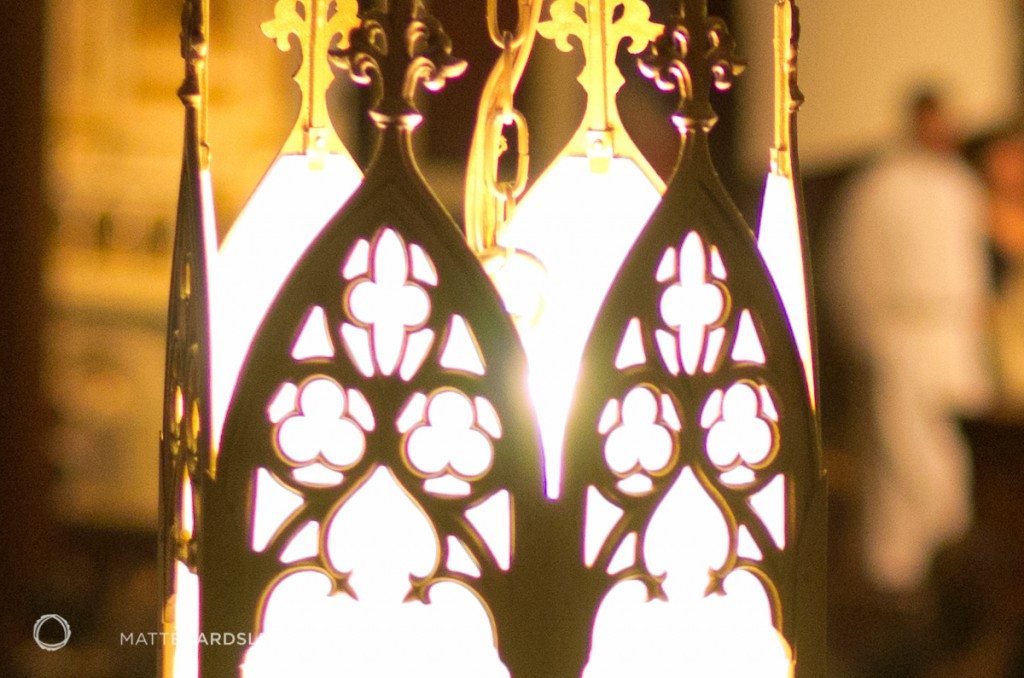Last Updated on 07/17/2011 by Chris Gampat
The other day the I shot a wedding and brought along the Pentax K-5. So far, I believe that the Pentax K-5 is a great event camera, offering a respectable 16.3 MP; compact dimensions; intuitive, creative controls; and a remarkable maximum ISO reach of 52,200. I photographed a wedding this past week and took along our demo K-5 with its Pentax SMC 55mm f/1.4 DA* lens. After the jump: a discussion of Pentax’s flagship 35mm DSLR and its appeal for wedding photography…
Editor’s Note: Day 1 and Day 2 are here for your reading pleasure.
Handling
The Pentax K-5 is a smooth handling camera with controls that are intuitive and that can be easily customized. I appreciate the prominent placement of the camera’s ISO and White Balance controls as well as it’s easy way of switching between auto and manual focus.
This particular wedding was an intimate and quiet event, and was held in a reverberating church that seemed to amplify every sound. The K-5’s exceptionally smooth and quiet sound was a useful advantage (a much more discreet sound than the prominent CLAP of my Nikon D3). Together with the camera’s unassuming size, the sound helped me to be less of a distraction during the service. The volume of the autofocus confirmation beep can also be adjusted or disabled, as can the unique green autofocus assist lamp.
The camera had no trouble autofocusing, even in a dimly lit church. Perhaps other cameras will more fluidly track a couple whirling on a dark dance floor, but the K-5is not far behind the best in the game. The automatic exposure did a great job making selections in both program and aperture priority modes. It seems to prefer preventing highlight blowout to delivering amped up mid tones, which is a good strategy and one that the K-5 follows with awesome predictability and consistency. The exposure compensation control is placed for quick adjustments and a handy warning icon in the viewfinder is a nice reminder when it’s in use.
The camera’s “green button” is a unique and handy exposure tool. Its function varies a little from mode to mode and can be customized, but it usually reverts aperture and shutter settings to the camera’s calculated values. In manual exposure mode, for example, a quick press quick sets what would have been the program mode choices. In program mode, both control wheels can be used to alter either setting, with the camera matching the other (it’s like aperture priority and shutter priority in one) and the green button will revert both to the metered values. Pretty cool! It’s also worth noting that the camera is a bit more aggressive that others I’m used to when it comes to aperture. It is not afraid to hold the 55mm wide open and did a nice job keeping shutter speed hand-holdable. To add options (in line with the Pentax’s amazing degree of customize-ability) a K-5menu allows a selection from six “program lines”, tailoring the camera’s shutter and aperture selections for landscape, action, shallow focus, etc.
To sum it up, I’d say the K-5is a nimble and discreet camera for photographing events and weddings. It is a nice size for slinging around and has both familiar professional controls, smart and unobtrusive assistance when asked.
One curious note needs to be added regarding the camera’s processing speed. Every time I’d fire off a quick round of RAW files and then press the playback button for a quick review, all I’d see for three or four seconds was a little hourglass on the LCD. At times, the camera has a frustrating delay in pulling up images for review, especially frustrating during high-pressure shooting. Granted, I have numerous processing-pushing options selected, like noise reduction, lens correction, chromatic aberration correction, shadow correction, etc. I hope readers share their own findings in the comments below. It’d be interesting to see if it’s a unique problem for me and our demo unit. For the shoot, I used a SanDisk Ultra II, which is a bit dated and could be slowing the process down. I’ve placed an order for a more contemporary card and hope the problem will be largely fixed. More on that in a future post!
Image Quality
In the all-important area of image quality, the Pentax K-5 has a lot going for it and one notable problem. First the good news. The files are big, clean, and extremely flexible. They have the depth and range to pull strikingly clean, usable detail from the deepest shadows, especially at low ISO. Shooting RAW and at low ISO, the files have tremendous dynamic range, as good as any 35mm DSLR at any price, though, as should be expected, the reach diminishes as ISO increases. The 55mm f/1.4 DA* is a sharp lens and well-matched to the K-5 sensor.
The images here, unless otherwise noted, were all shot at ISO 1600. At that sensitivity, there is obvious grain, though it is very fine and not unattractive. I use the word “grain” and not “noise” because, while technically inaccurate, the camera’s noise is nothing like the ugly TV static that has plagued digital capture for years. At 100% zoom, it is much more velvety and natural looking. Also, it takes a zoom to really spot the camera’s noise, which is impressive.
Color rendition is another strong point for the K-5. For JPEG processing the camera has an awesome range of options and settings to tailor output to individual tastes. For RAW capture (and the images for this post are all DNG capture) files are extremely neutral and color accurate. The camera’s auto white balance is quite good and can be adjusted via an intuitive blue/green/amber/magenta matrix to deliver the desired result (I warmed up the camera’s interpretation a bit). White balance can also be manually measured, set for a specific Kelvin or Mired number, and further tailored via custom menus. All of that makes for a customizable and consistent color treatment (did I mention how easy this camera is to customize?) Consistent with the camera’s low light abilities, color rendering holds together nicely as light decreases.
The camera’s sharpness is also a plus. RAW files can handle a good bit of post-processing sharpening, and under default settings, K-5JPEG files have a great balance of sharpened detail and noise correction.
My one notable problem is noticeable and distracting purple fringing. On our unit of the K-5, back-lit images and images with abrupt transition from strong highlights have an awful tendency towards chromatic aberration. I first noticed the issue in a direct comparison with a Canon 50D (predecessor to both the current Canon 60D and 7D). Pentax was generous to send a second 55mm f/1.4 DA* overnight for more testing and the new lens is certainly an improvement (we believe the first copy was damaged at a trade show before coming to me). On certain images, though, I’m still getting a distinct purple band around areas of strong tonal transition. Perhaps it’s an issue with an early production model, or something that can be fixed via firmware. I’ve attached a couple more images as illustration of our test camera’s problem.The first is a crop of the image at top of the section. The second is a quick photo of my son which is not terribly interesting, but clearly illustrates the issue. Click the thumbnails to see larger images.


It’s certainly a problem, and one that is bad enough to most likely be an irregularity. I’ll check with Pentax and update this entry if a solution is found. I should add that there are definite benefits to “buying in” to a relatively small company like Pentax. I am a registered Nikon Professional and can say that, over the years, Pentax has been a more accessible and responsive company (in the past, I’ve owned a Pentax DSLR and several lenses). Their customer service has always been quick to answer e-mails and offer helpful advice.
Low Light Performance
Though I’ve discussed high ISO shooting, it’s worth adding that the Pentax K-5has a lot going for it when the lights go down. The camera has in-body image stabilization that works well to counter jittery hands like mine. It’s handy that the effect essentially applies to all lenses. Certainly it is nice to “preview” the effect through a Nikon or Canon lens. With the K-5’s sensor moving and not a lens element, there’s no way to see what’s happening through the viewfinder. Curious photographers can activate the camera’s live view and try it out, the camera makes some alarming sounds as it jerks the sensor around to counter camera motion, but it holds a still image. Also, Pentax has a respectable line of lenses, including a long history of fully-compatible glass on the used market. The camera’s “shake reduction” combined with remarkable high ISO performance, fast glass, and a velvety-dampened mirror mechanism makes for a camera that will have some photographers packing away their tripods for good.
Conclusion
I really enjoyed adding the K-5to my usual kit for a wedding. It is quick and responsive, stealthy, and delivers big, beautiful images (especially for a cropped-sensor camera). It is unbeatable for customization and a joy to operate. In my testing, I discovered two curious issues, an especially slow response time when displaying images for review and strong purple fringing in certain back-lit situations. A problematic SD card may be responsible for the playback delay (more on that in a future post). My purple fringing issue may be isolated to our test camera, but it is certainly cause for alarm. Please comment below if you have experienced a similar issue or have a K-5
that does not have this problem.
In my next post, I’ll discuss portrait shooting with the Pentax K-5 and pass along any updates on the issues discussed above. Till then, thanks for reading!
Please Support The Phoblographer
We love to bring you guys the latest and greatest news and gear related stuff. However, we can’t keep doing that unless we have your continued support. If you would like to purchase any of the items mentioned, please do so by clicking our links first and then purchasing the items as we then get a small portion of the sale to help run the website.




